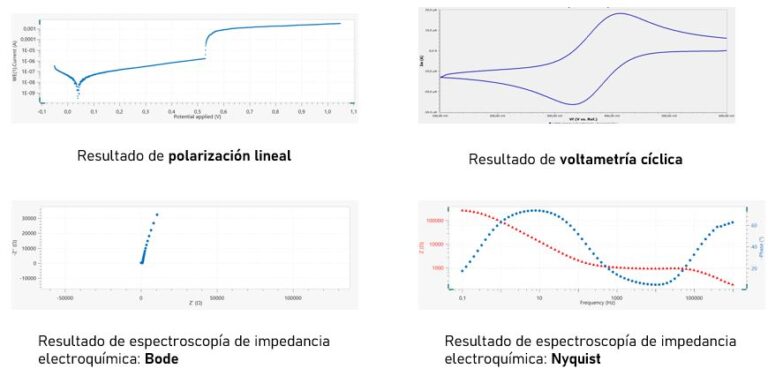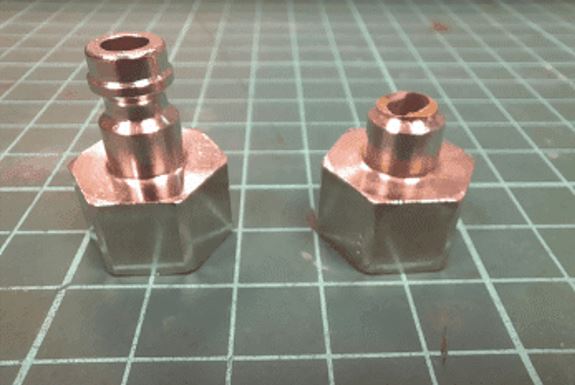What is the Potentiostat?
The Potentiostat is a high-precision instrument designed to measure and control current and potential flow in electrochemical experiments. This instrument is essential for researchers and technicians working in electrochemical reaction analysis, corrosion studies, and materials characterisation.
Using advanced techniques such as electrochemical impedance spectroscopy (EIS) and cyclic voltammetry, this potentiostat allows precise control over experimental conditions, providing highly reliable and repeatable data.
Its compact design and ability to integrate with specialised software make it an ideal tool for modern laboratories.

How does the potentiostat work?
The operation of the Potentiostat is based on the application of a controlled potential on an electrochemical system while simultaneously measuring the resulting current.
The equipment consists of a signal generator, a measurement system and an electrochemical cell. During the process, the working electrode interacts with the sample, while the collected data are processed by the software, generating graphs and tables that facilitate the interpretation of the results. This allows researchers to analyse in detail phenomena such as corrosion, chemical reactivity, and conductive properties of liquid and solid materials.
Interpreting the results obtained with the Potentiostat is easy thanks to its integrated software, which allows the data to be displayed in real time. The process begins with sample preparation, setting the measurement parameters and selecting the appropriate technique, such as voltammetry or impedance spectroscopy.
Once the analysis is complete, the results are presented in the form of curves and spectra, where each parameter can be evaluated to determine properties such as corrosion resistance, conductivity, or the ability of electrolytic coatings. This functionality facilitates a detailed and efficient analysis, optimising time in the laboratory.
Below are some of the results that can be obtained by performing different tests:

Benefits of the potentiostat
A key benefit of the Potentiostat is its versatility in industrial and research applications, as it can be adapted to multiple types of electrochemical analysis. Its ability to measure both surface and liquid properties makes it an indispensable tool for industries such as automotive, pharmaceutical and energy. In addition, its high sensitivity and accuracy ensure reliable results even in studies that require detection of extremely low concentrations of reagents.
Potentiostat Equipment
INFINITIA has two potentiostats, the Gamry 600 Potentiostat and the Autolab M101 Potentiostat. These devices stand out as two advanced options in the field of electrochemical instrumentation, designed to meet the analysis needs on research laboratories and quality control. Both models incorporate state-of-the-art technology, offering accuracy and versatility in a wide range of electrochemical applications, such as corrosion studies, coating characterisation, and fuel cell analysis.
The Gamry 600 has a current range of ± 600 mA and a potential range of ± 12 V, making it ideal for experiments requiring precise control of electrochemical conditions.
One of its most outstanding functionalities is the electrochemical impedance spectroscopy (EIS), with a maximum frequency of up to 1 MHz, which allows characterising materials and systems in a wide range of frequencies. In addition, this model includes an advanced filtering system that reduces measurement noise and ensures consistent results, even in highly sensitive experiments. Its integration with the Gamry Framework software facilitates programming and analysis of experiments using graphical tools and advanced settings.
On the other hand, the Potentiostat Autolab M101 is known for its modularity and compact design, which makes it particularly suitable for customisable configurations and specific applications. This model stands out for its ability to integrate additional modules that extend its functionalities, such as impedance spectroscopy and advanced voltammetry techniques.
Its intuitive interface and compatible software allow efficient data management and detailed analysis of results. In addition, the Autolab M101 features long-term measurement stability and accuracy, making it a reliable choice for demanding research in sectors such as energy, biotechnology and materials chemistry.
Both the Gamry 600 and Autolab M101 offer complementary features that make them indispensable solutions for laboratories seeking reliable and advanced results in the field of electrochemistry. The choice between them will depend on the specific needs of the laboratory and the applications for which they are used, always ensuring high performance and precision in each experiment.
On the other hand, the Autolab M101 potentiostat stands out for its modularity and compact design, which makes it particularly suitable for customisable configurations and specific applications. This model stands out for its ability to integrate additional modules that extend its functionalities, such as impedance spectroscopy and advanced voltammetry techniques.
Its intuitive interface and compatible software enable efficient data management and detailed analysis of results. In addition, the Autolab M101 features long-term measurement stability and accuracy, making it a reliable choice for demanding research in areas such as energy, biotechnology and materials chemistry.
Both the Gamry 600 and Autolab M101 offer complementary features that make them indispensable solutions for laboratories seeking reliable and advanced results in the field of electrochemistry. The choice between the two will depend on the specific needs of the laboratory and the applications for which they are used, always guaranteeing high performance and precision in every experiment.

Applications of the equipment
The potentiostat has a wide variety of applications in various industrial and research sectors. The most relevant ones are presented below:
- Quantitative measurement of corrosion resistance: This equipment is ideal for corrosion studies on metallic and non-metallic materials. It allows the evaluation of corrosion resistance under different environmental and chemical conditions, which is essential in sectors such as construction, automotive and shipbuilding. The potentiostat’s ability to perform accurate analysis helps to optimise material selection and develop effective corrosion protection strategies.
- Assessment of water hardness and scale deposits: In the field of water treatment, the Potentiostat is used to measure water hardness and analyse the formation of scale deposits. This application is essential for industries such as energy and food, where scale build-up can affect the efficiency of equipment and the quality of the final product.
- Detergency and reactivity analysis: This equipment is widely used to evaluate the effectiveness of cleaning agents and their interaction with different surfaces. It allows the chemical reactivity of detergents and cleaning agents to be measured, optimising their formulation and ensuring that they meet the required quality standards.
- Electrolytic coatings and cleaning: In the field of applied electrochemistry, the potentiostat is a key tool for studying electrolytic coating and cleaning processes. It allows the uniformity, adhesion and resistance of coatings on metallic and non-metallic surfaces to be analysed and is essential in the automotive, aerospace and medical device industries.
- Analysis of conductive surfaces and liquids: Thanks to its high sensitivity and adjustability, this potentiostat is ideal for the analysis of conductive surfaces and liquids. This includes studies of advanced materials, such as conductive coatings and complex electrochemical solutions, used in the development of batteries, fuel cells and sensors.
- Electrochemistry in pharmaceutical research: In the pharmaceutical sector, the Potentiostat is used to study chemical interactions and properties of active compounds. It allows the stability and reactivity of drugs to be analysed, optimising their design and formulation.
- Development of sensors and electronic devices: This equipment is essential for the development of electrochemical sensors and advanced electronic devices. Its accuracy and versatility make it an ideal tool for characterising materials and evaluating their performance under real-world conditions.
- Quality control in hydrogen fuel cells and batteries: In the energy industry, the potentiostat is widely used to analyse the performance and durability of batteries. It allows to evaluate their charge and discharge capacity, as well as to identify possible defects in the materials, ensuring their efficiency and safety.
In conclusion, the Gamry 600 Potentiostat and the Autolab M101 are two advanced and versatile instruments that play a key role in the analysis and development of electrochemical technologies. Their precision, sensitivity and adaptability make them indispensable tools for research and quality control laboratories in a wide range of industries.
At INFINITIA, these instruments are used to perform detailed analyses that contribute to the advancement of research, failure analysis and forensic engineering, and to the development of innovative solutions in fields such as energy, chemistry and materials engineering.
Here are some examples of the use of the potentiostat at INFINITIA:
Comparison of corrosion resistance to select the optimum surface finish.




